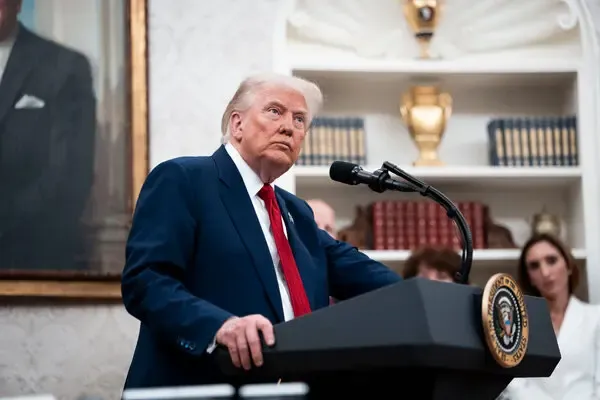Published 06 Nov 2025
US Supreme Court Casts Doubt on Legality of Trump’s Global Tariffs
The US Supreme Court has cast doubt on the legality of former President Donald Trump’s global tariffs, questioning the limits of executive power in trade decisions.

Introduction
he US Supreme Court has raised serious questions over the legality of former President Donald Trump’s global tariffs, signaling a potential shift in how much authority the White House can exercise over trade policy.
The case, which stems from Trump’s decision to impose sweeping tariffs on steel and aluminum imports in 2018, has reached the nation’s highest court after years of debate, economic impact, and international tension.
Background: Trump’s Tariff Policy
In 2018, then-President Donald Trump used a rarely invoked law — Section 232 of the Trade Expansion Act of 1962 — to impose tariffs on imported steel (25%) and aluminum (10%), citing national security concerns.
The move sparked global controversy, straining relations with close allies such as Canada, the European Union, Japan, and South Korea, and prompting retaliatory tariffs on American goods.
Critics argued that Trump’s justification was *too broad, using national security as a cover for protectionist trade policies, while supporters claimed it was necessary to *defend American industry and jobs.
Supreme Court’s Concerns
During the latest hearing, several Supreme Court justices expressed skepticism about the extent of presidential power used to enforce such trade measures without congressional approval.
Justice Neil Gorsuch questioned whether the executive branch should have the ability to label almost any import as a “national security threat.”
He said,
“If national security can mean anything the president wants it to mean, then what limits are there to this authority?”
Other justices echoed concerns that the current law grants excessive discretion to the president in setting trade restrictions, effectively bypassing Congress — the branch traditionally responsible for controlling trade and tariffs.

Legal Challenge and Broader Implications
The case was brought forward by domestic manufacturers and importers who argued that Trump’s tariffs led to higher costs, disrupted supply chains, and violated constitutional limits on executive power.
If the Supreme Court ultimately rules against the tariffs, it could reshape future trade policy, restricting presidents — including the current administration — from using similar powers without congressional oversight.
Legal experts say the ruling could have long-term consequences for how the United States handles trade disputes and economic security in an era of rising global competition.
Biden Administration’s Position
While President Joe Biden kept several of Trump’s tariffs in place, his administration has adopted a *more targeted approach, negotiating exemptions with allied nations and focusing on *strategic economic cooperation.
However, the Biden administration has also defended the legal basis for keeping certain tariffs, arguing that Section 232 authority remains a vital national security tool.
Trade analysts note that a Supreme Court decision limiting this power could also curb Biden’s ability to respond quickly to global supply disruptions or economic threats from countries like China.
Reaction from Economists and Industry
Economists have long debated the effectiveness of Trump’s tariffs.
While they offered short-term protection for some American steel and aluminum producers, they also raised prices for manufacturers and reduced exports due to foreign retaliation.
Industry groups welcomed the Supreme Court’s review.
The National Foreign Trade Council (NFTC) said in a statement,
“This case is about restoring balance between Congress and the executive branch. No single president should have unlimited power over trade policy.”
Meanwhile, unions representing steelworkers argued that removing the tariffs could *hurt domestic jobs, warning that *foreign imports could again flood US markets.
Political Response
The development has reignited a political debate in Washington.
Republicans close to Trump have defended his tariffs as *bold and necessary, while Democrats argue they *hurt consumers and damaged global partnerships.
Some lawmakers are calling for new legislation that would clarify or limit presidential authority under the 1962 Act, ensuring that future trade actions require greater congressional involvement.
What Happens Next
The Supreme Court is expected to issue a formal ruling in the coming months.
If the justices strike down Trump’s tariffs, it could set a landmark precedent, redefining executive power in matters of trade and national security.
Analysts say the decision will not only impact Trump’s legacy but could also shape future administrations’ ability to act unilaterally in economic matters.
In Summary
- The US Supreme Court is reviewing Trump’s 2018 global tariffs.
- Justices questioned the broad use of national security to justify trade barriers.
- The case could limit presidential authority and strengthen Congress’s trade oversight.
- The Biden administration is watching closely, as the outcome could affect current trade policies.
Conclusion
The Supreme Court’s skepticism marks a pivotal moment in America’s ongoing struggle to balance economic protectionism, global trade, and constitutional limits on power.
Whatever the final verdict, the ruling is expected to have far-reaching implications — not just for Donald Trump’s trade legacy, but for how future presidents navigate the delicate intersection of national security and economic policy.

Dr Sudheer Pandey
94% of readers found this post helpful
0 Votes
Click a star to add vote